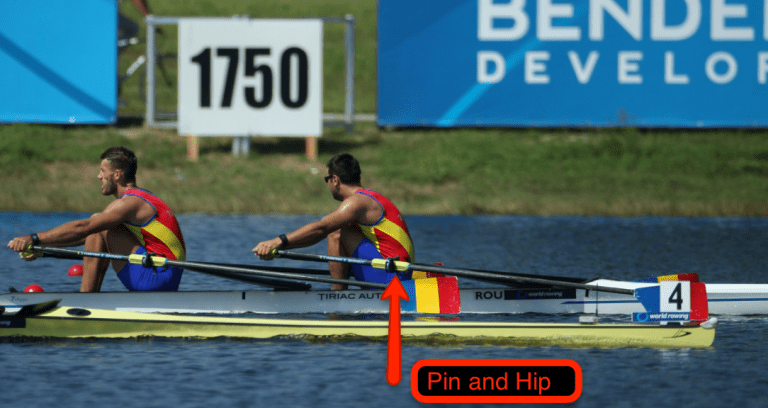Marlene Royle has some rigging tips for situations when you have an athlete who is not flexible and finds it hard to get into the correct position for rowing. These originated in the Rowing Technique and Aging podcast episode. And are covered in more detail in the Adapting Technique ebook. 
First set the heights
Marlene advises that “Oarlock height comes first”. Check that when the athlete sits at the finish with the oar / scull handles at the end of the drive phase (so buried under the water). Check that the handles come to the athlete’s centre of gravity – this means, Drawing the Handle In (as explained in The Rowing Stroke Cycle – the Finish)
To draw the handle to the appropriate height, usually around the first rib, the shoulders are opened, shoulder blades squeezed together, and the elbows drawn past the chest. This requires that the lower back is held firm to provide the base off which the upper body can work. The pelvis should be in the neutral position and the lumbar spine straight and aligned with the pelvis. The shoulders stay low and move only in the horizontal.
One easy test of whether the heights are correctly set is Can you rest weight over the top of the oar handles? This means can they maintain pressure on the handle through to the extraction without the spoons coming out of the water and without the handles being so low that there’s no space to extract a square blade and clear the water surface.
Second adjust the foot stretcher
Prioritise the entry angle when choosing foot stretcher position. This means when setting a crew (and you want all the oar shafts parallel through the stroke) you may have to make compromises between different athletes due to their flexibility. This leads to the question – should they be set up to be parallel at the finish or the catch. Marlene counsels at the catch or entry.
Her reasoning is that the catch is the place where there is more opportunity to create boat speed if all the oars are aligned than the finish when the majority of power has already been delivered before the oars get to the finish. And so you are more likely to optimise boat speed if catch angles are aligned.
Third compression forwards

The rule of thumb about the sternward compression of the athlete as they roll up the slide towards full compression is that the front stops on the slides need to be 2 centimeters forward of the face of the gate. Marlene, goes further. Her advice is that the athlete’s centre line of the hip should be at the centre of the pin (or a bit stern-wards). This is a more accurate measure than just setting the slides because it reflects the ability of the athlete to compress and to get to the full compression position. Best way to assess this is through video shot at 90 degrees to the athlete and then freeze-frame to where each athlete reaches full compression. If you shoot from low down close to the water surface, you will be able to make a good judgement about the alignment of the athlete’s hip with the pin. It also helps if the athlete has stripes down the side of their row-suit.
What else would you add as tips for rigging for inflexible athletes?







This Post Has 2 Comments
Rebecca I am A masters rower and find it extremely hard to get into full compression. My coach just shouts at me and tells me to make a change , which I am finding very frustrating and unhelpful. I have ordered a seat pad to raise my seat height and was wandering of you could suggest any other changes I could make in my boat. I also row over a barrel in an arch. I am down for every session and try to make changes I am just not able to get it into my head what to do. Can you help me? Is it me or the rigging?
Robert
your commitment is impressive – the thing about flexibility is that it’s time consuming to change…. and as older athletes it takes longer to change.
Here are some suggestions
1 – go to a sports masseuse or an osteopath and ask them to give you a massage to loosen up the joints / muscles which are not as flexible as you coach wants. This could be a once a week for a month programme to help you on your way
2 – ask the same person to give you stretches to do daily to improve your flexibility. Or buy Yoga for Rowers from our shop… read this review by Anna who spent a couple of months doing the exercises. If you’ve never done yoga before, go to a class a couple of times so you know the basic postures and how to get into them (it’s easier to be shown than to copy a photo with your head between your knees!!)
3 – if part of your flexibility challenge is your ankles and getting compressed into the catch, brush your teeth every morning and night squatting on teh floor in the catch position. Two minutes in that posture twice a day is a great stretch aide.
Let me know how you get on!
Rebecca